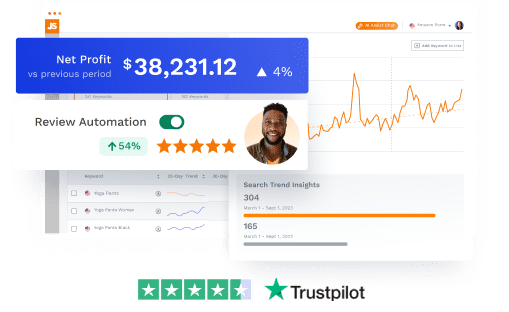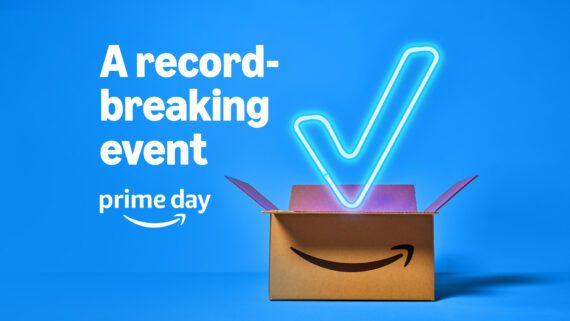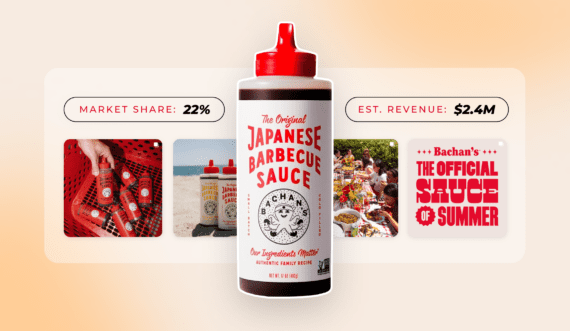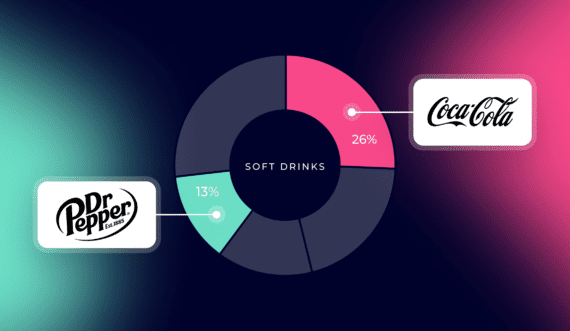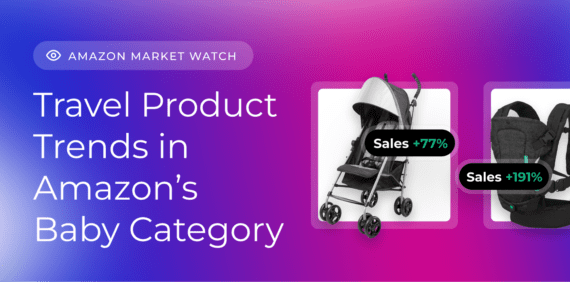Content
expand_moreHave you ever launched an Amazon ad campaign and been met with just a trickle of orders? It’s an incredibly frustrating experience for any e-commerce business, but unfortunately, not an uncommon one.
The problem typically isn’t your product but rather your advertising strategy. Too often, companies will heavily invest in ads without a structured plan to optimize and scale ads, leaving them with disappointing results and wasted ad spend.
So how can you expand and refine your Amazon advertising strategy to ensure that every dollar you spend is an investment and not a gamble? We’ll explain it within this article in three parts:
- Part 1: Why Your Amazon Ads Are Underperforming
- Part 2: How to Optimize Your Ad Campaign
- Part 3: How to Scale Your Amazon Ads
If your Amazon ads aren’t working, identifying the root cause is your first step. Then, you can use those learnings to craft a strategic Amazon PPC campaign. Once you gain some traction with your new Amazon advertising efforts, you can dive into how to scale ads for greater success.
Are you ready to invest?
Amazon PPC advertising is a long-term effort that requires your money and time. If you don’t have the time to invest in learning how to optimize your ads properly, you risk hurting your business. In this case, collaborating with an Amazon advertising agency may be a better option.
Amazon PPC agencies live and breathe Amazon selling strategies. An Amazon ad partner can manage your store and advertising campaigns for you, so you can skip the learning curve and simply watch the sales come through.
Rather learn the tools and tricks of the trade to manage your own Amazon ad strategy? Let’s get to it.
Part 1: Why Your Amazon Ads Are Underperforming
Before you fix a problem, you need to know what needs fixing. There are several reasons why your Amazon ads may be falling short of expectations, but these are the five most common issues:

Problem #1: Inadequate keyword research
One of the most common mistakes with Amazon Advertising is not spending enough time on keyword research and skipping out on long-tail keywords. Some mistakenly think keywords are only important for product listings, but you’ll need them for your advertising campaign, too. Find what’s unique about your product and target the longer more specific terms to get an initial sales foothold.
Quick refresher: Long-tail keywords are longer and more specific phrases used as search terms on search engines. They’re typically three or more words, making them more targeted and less competitive. For example, if you’re selling sandals, a generic keyword is “beach sandals,” while a long-tail keyword could be “women’s beach sandals size 7.”
Problem #2: Poorly optimized listings
Maybe it’s not that your ads aren’t working but that they’re not converting. If you see that your ads are driving traffic but you’re not seeing an increase in sales, the problem might be your product pages. Your listings should be well-optimized not only with keywords but also with high-quality visuals, detailed descriptions, and competitive pricing.
Problem #3: Bad ad placements
If your ads aren’t showing up in front of the people searching for your product, they won’t lead to sales. You may need to adjust your settings to better optimize your Amazon advertising campaigns for maximum visibility. Ideally, your ads should pop up on the first page of search results and on any relevant product detail pages.
Problem #4: Neglecting negative keywords
Negative keywords are words or phrases you don’t want your ads to appear for. It’s important to implement negative keywords to filter your advertising efforts, or you risk wasting money on ad placements in front of the wrong customers.
Back to the sandals as an example: If you sell casual beach sandals meant for every-day use, you might want to choose “dressy sandals” or “formal sandals” as negative keywords. If you don’t, your casual sandals might pop up for someone searching for high-end sandals to wear for a wedding—a waste of ad spend.
Problem #5: Lack of A/B testing
Another common mistake with Amazon Advertising is not conducting A/B testing. A/B testing involves running two versions of an ad (with different elements such as images, copy, or call-to-action) and comparing their performance to see which one gets more clicks and conversions. A/B testing can help you fine-tune your ads and improve their overall effectiveness.
Part 2: Optimize Your Amazon Ad Campaign in 5 Steps
Optimization is a word you likely hear a lot in the world of e-commerce: keyword optimization, search engine optimization, ad optimization, etc. When it comes to your advertising strategy, campaign optimization means making smart adjustments to your process to get the best possible results.
Below is a five-step guide to optimize your Amazon ad campaign to improve performance:

Step 1: Review your campaign goals
If your Amazon ads aren’t working, it’s likely time to head back to the drawing board, and that starts with reviewing your campaign goals.
Of course, the easy goal is “to sell more products and make more money.” But you want to be a bit more specific here. Most companies are generally after one (or a mix) of three main advertising goals:
- Cost efficiency: To enhance your campaign’s cost efficiency, focus on reducing advertising cost of sales (ACoS). Establish a target ACoS based on past performance and industry standards, then adjust your ad spending to meet or surpass this goal. Monitor which ads and keywords generate the best returns so you can adjust your strategy accordingly.
- Revenue growth: If your main goal is to increase revenue, set your efforts on maximizing your return on ad spend (ROAS). Refine your target audiences and enhance advertising creatives to boost engagement and conversions.
- Brand visibility: Advertising isn’t always about making the sale (at least, not at first). Establish a target share of voice (SOV) and implement strategies—increasing ad spend, diversifying advertising channels, employing aggressive promotional tactics, etc—to achieve it. Watch what your competitors are doing and adjust your strategy accordingly.
Step 2: Use keyword research tools (or experts)
If you’re simply guessing which keywords are best for your Amazon advertising campaign, you’re likely throwing dollars out the window.
You can use expert research tools like Jungle Scout’s Keyword Scout to find high-converting keywords relevant to the products you’re trying to promote. Keyword Scout also helps you discover more unique keywords to give you a leg up on your competition. Be sure to include long-tail keywords (they can be highly lucrative) and negative keywords in your strategy.
It’s not just about finding keywords to optimize for. Here are some other keyword tips to follow:
- Target indirect keywords.
- Use branded keywords and self-targeting tactics.
- Don’t put all your keywords in one campaign.
- Include negative keywords as a filter so your ads will only appear where relevant.
You don’t have to be an optimization expert, but there is a learning curve to effective keyword research. The Jungle Scout Academy is a great place to learn if you have the time to hone your skills. Or, you can enlist the help of an Amazon advertising strategist who’s already well-versed in all things keyword research and advertising strategy.
Find the keywords that count with Keyword Scout.
Instantly discover high-converting keywords for your listing and get critical insights into your competitors’ keyword strategy.
Step 3: Create retail-ready product pages
As mentioned, the problem might not be with your ads, but with your product pages. Having a click-worthy ad means nothing if the customer gets to your product page and is turned off from making a purchase. Here’s a few things you can do to make an enticing, ad-ready product page.
- Relevant and attention-grabbing product title that includes brand name and main keyword.
- Clear and well-optimized product description.
- Aesthetically pleasing, high-quality images and videos.
- Brand-enhanced content (if you are brand registered on Amazon).
- At least 15 customer reviews, ideally rated 3.5 stars or higher.
Step 4: Expand your audience with market basket analysis
Maybe your Amazon ads aren’t working because you’re targeting the wrong audience, or too small of an audience. Doing keyword research and analyzing Amazon’s customer behavior data can help you pinpoint your ideal audience so you can create ads that speak to the right people.
Amazon’s advertising capabilities allow you to utilize market basket analysis (MBA), a data extraction method that reveals patterns among items. MBA is typically used to reveal products that are frequently bought together, which can lead to a cross-promotion strategy to target more potential customers who may not have been initially looking for your product.
Back to our earlier example, this could look like placing ad targets on customers buying bathing suits or beach totes to increase sales of your beach sandals.
Step 5: Adjust your Amazon bidding strategy
Managing PPC bids is one of the biggest challenges for small and medium Amazon businesses, according to the 2024 State of the Amazon Seller report. There are several Amazon ad bidding strategies out there, and finding what’s best for your company involves some trial and error.
When starting out, it’s recommended to use Amazon’s automatic targeting campaigns and choose from one of the three types of bidding strategies:
- Dynamic bidding (down only) is when Amazon automatically lowers your bids when you’re less likely to make a sale.
- Dynamic bidding (up and down) adds a second component on top of the down-only strategy by increasing your bid by 10% during times when you’re more likely to make a sale.
- Fixed bids means you set your bid and it doesn’t change until you choose to adjust it. We recommend starting with daily budgets and default bids 50-100% higher than what Amazon suggests.
There is a widely-used formula to calculate an ideal Amazon advertising bid:
Bid = Maximum Cost per Click = (Ad Sales / Ad Clicks) x (Ad Spend / Ad Sales)
Part 3: How to Successfully Scale Ads on Amazon
We want to clarify something: Scaling your Amazon ads isn’t a beginner-seller strategy. It’s time to scale your ads on Amazon when you’re seeing positive campaign results that you want to turn from good to great.
Switch to manual campaigns
Now that you’ve gotten the hang of the Amazon ad platform and have seen positive results, you can shift your campaign from automatic to manual for greater control of your ad spend and bidding strategy.
You can pinpoint your bidding strategy to take advantage of current trends and market insights, thanks to Amazon’s endless supply of data. You can also leverage AI and machine learning tools, like Jungle Scout Cobalt to hand-deliver these valuable insights to you.
Choose your method: horizontal vs. vertical ad scaling
There are two ways to scale ads: horizontally or vertically.
Horizontal scaling
When you scale ads horizontally, you spread your ad budget across several ad sets simultaneously, targeting different groups of people with the same ads. To paint a visual, horizontal scaling is like planting a bunch of different seeds in a wide plot of land and waiting to see what grows.
Horizontal ad scaling amplifies your reach, getting your ad in front of more people. The downside is that you may very well start competing with yourself, which is obviously not ideal. Plus, if your ad isn’t great, you may have just wasted money showing an inadequate ad to multiple audiences.
Vertical scaling
On the other hand, vertical scaling involves investing in a single ad set or campaign and slowly increasing the budget based on how it performs. It’s more like planting a single seed and focusing all your efforts on nurturing it. When it shows growth, you intensify your efforts to make it flourish.
Vertical scaling is a beneficial strategy because you can focus on creating a really great ad campaign and continuously optimizing it to gain incredible results. The vertical scaling strategy often makes a bigger impact within a more narrow audience, leading to higher conversions overall.

Increase your budget using the 80/20 rule
One of the best ways to ensure you’re spending your ad dollars effectively is to use the 80/20 rule, AKA the Pareto principle. The Pareto principle states that 80% of consequences come from 20% of causes, but in Amazon PPC advertising, it translates to 80% of your sales coming from 20% of your keywords.
You can find out which 20% of keywords are producing your sales by downloading a Search Term Report in Seller Central. To do this:
- Under the Reports page, select ‘Create Report.’
- Choose your campaign type (Sponsored Product, Sponsored Brand or Sponsored Brands Video).
- For the Report Type, select ‘Search term.’
- For the time unit, select ‘Daily.’
- For the report period, choose ‘Last 60 days’
- Click ‘Run report’ and then download the data.
When your spreadsheet opens, you can filter the report by 7 Day Total Sales to find the most relevant converting keywords. You’ll want to look for the customer search terms that have multiple sales and a click-through rate (CTR) above 0.4% (that’s average for Amazon).
Now, you can better focus your Amazon campaign strategy, increasing your ad spend on these winning terms.
Monitor and adjust your ad campaign
Consumer behavior is constantly changing, and so is Amazon. That said, a “set-it-and-forget-it” approach doesn’t really work here. You have to constantly monitor your ad data and A/B tests to see what’s working and what isn’t.
You can automate this process using an Amazon PPC manager to gather round-the-clock, data-driven recommendations. The Jungle Scout platform also allows you to gather valuable Amazon customer and advertising data in real time to better optimize your campaigns. There are a few ad performance metrics to monitor:
- Click-through rates (CTR)
- Conversion rates
- Return on Ad Spend (ROAS)
Keep in mind that Amazon ad scaling is a slow process—your campaigns need some time to bake. After you implement scaling strategies, give them a couple of weeks to show results, then analyze your data and make adjustments accordingly.
A Final Word On Ad Scaling
As you’ve likely gathered, scaling your Amazon ads is a lot more strategic than simply increasing your ad spend. Of course, you need to spend money to make money, but the key is making sure you’re spending that money effectively so your sales revenue is much higher than your ad spend.
That said, investing in ads is just one part of the strategy. Amazon advertising requires continuous learning, analysis, and implementation, so you must also invest your time into staying sharp. Using Amazon Seller tools like Jungle Scout can help business owners of any size learn the tricks of the trade for incredible advertising results.
There’s little time to waste in the competitive world of Amazon. With this strategy and the right tools in hand, now’s the perfect time to transform your ad dollars into significant sales growth and seller success.
Use Jungle scout to scale your Amazon business.
Spencer Padway has taken a dedicated approach to e-commerce marketing since 2009, specializing in growing brands holistically across DTC, Amazon, and smaller retailers to gain better data, insights, and returns. He is the founder and CEO of Search Nurture and the owner of Project FBA and Infinite FBA. His agency has helped many large brands sell millions of products on Amazon, while his blog helps hundreds of thousands of sellers sell their products yearly. Spencer has worked with large and small brands, ranging from brand-new to household names such as Jergens, Kate Spade, and Oneida. Spencer provides a unique perspective on marketing, as he can view challenges from multiple angles, given his diverse background. He has a strong drive to help brands grow in any way he can, offering hands-on services with his agency and insider tips through his blog to help smaller sellers learn essential DIY techniques.


